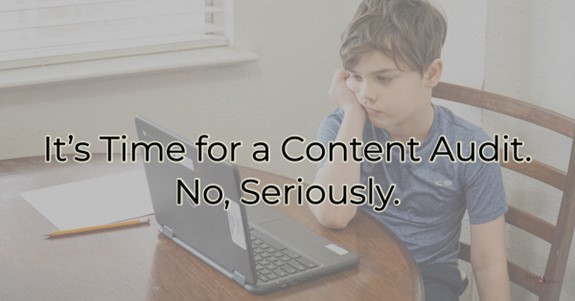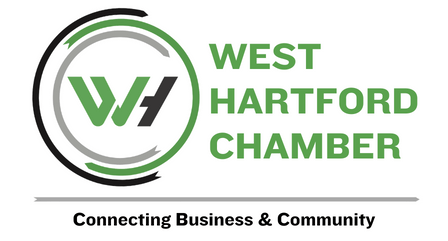It’s Time for a Content Audit. No, Seriously.

I can already hear the groaning—nobody reads, nobody likes to write. While we can argue these points forever and ever, it’s probably been a while since you looked at your business’ website content. If your content is stale and doesn’t resonate with your target audience, you need to fix that stuff now—even if you think no one reads anymore.

Why Audit Your Website Content?
Ineffective content is akin to a rude receptionist working at your front desk. But unlike the receptionist, with bad content you may not be aware how many people are losing interest in you. At least if you have an unprofessional receptionist, you might hear them yelling at clients or bungling calls and set them straight. With ineffective content, someone will be on your site, not find what they want, and never return. The only thing they’ll leave behind is perhaps a ding to your “time on page” rating with Google.How Do You Conduct a Website Audit?
Begin by getting a few things together. Whether that’s on paper or in your brain is up to you but here’s what you want to be clear on—your audience. Who are they, what do they do? What do they like? What troubles them? What do they need? Come to the audit with this knowledge in mind.You also want to be clear on your business goals. What do you want people to do on your website? Are they buying from you? Getting to know you? Figuring out how you’re different from your competition? Or all of these things?
Content Audit Checklist
When going through your content, ask the following questions about it. If something falls short, place it on a list to be refurbished. Don’t forget to add the “why” behind the rework. You won’t remember. Write it down.- Does this content make my ideal customer think, feel, or act? Could it be more compelling in any of these areas?
- What’s on the “top fold” of the site? Hint: it should be the main reason someone might look you up. If you’re not sure what that is—or if you have multiple—think about the one that has the best conversion rates. For instance, if you’re in real estate and you handle sales and rentals, but selling homes is your sweet spot, content about that should take up the prime real estate on your site.
- Is the content understandable for someone who knows nothing about buying what you sell? Is it clear what is being offered, how you would choose to buy it (why buy), and how you could buy it? Do you use language that someone new to your services would understand?
- Does it make it clear what can be expected when buying from you or using your services? No one will buy from you if they’re not sure what to expect and if they’ll be welcome. For instance, if I’m out of shape and looking for a gym, I want to find something that will welcome all ages and levels of fitness. I don’t want to be fat-shamed by people who look like the Rock. The personality of your gym is important. Many gym owners think offering a trial solves that problem, but most people won’t even try if they’re not sure.
- Does your word choice fit your audience? I used the word “akin” with a client the other day. She laughed and said I sounded like a bot. That word didn’t work for her or her audience. You want your visitors to have an ah-ha moment and feel like they know you and want to support you. Using language that doesn’t resonate with them is a no-no.
- Are you telling your story? Telling your story is a way to be memorable and help people connect with you. That’s seldom done through sharing the timeline of your business opening. You must go deeper than that. What’s behind what you do and how does what you do help your customers? Your story is their story.
- Where are your testimonies/reviews? Are they easy to find?
- Do your words accomplish what you set out to do? What are your goals for each webpage? Do your words move the visitors closer to that end goal? If not, rewrite.
- Are your stats and references up to date? Nothing screams “closed business” more than an out-of-date site.
- Do you have content for current customers? We’re often so busy selling that we forget about the people who already like us. What are you doing to make your brand a lifestyle? If you have a business that is not traditionally thought of as “sexy,” try incorporating a little humor to make your business a cult favorite. For instance, if you’re a plumber you could create t-shirts or business cards that read “We’re #1 in the #2 business.”
Content Audit for Advanced Marketers
If you have a carefully delineated sales cycle and customer journey, you’ll want to do all the above questions plus consider a few advanced audit concepts.However, if you don’t have a sales cycle/customer journey mapped, don’t worry. You may not need one. It depends on what you sell and the time it takes for a customer to decide to go with you. Short sales cycles (like buying gum) are impulsive purchases and don’t require a content-assisted sales journey. You don’t need to nurture customers as they decide over a pack of Wrigley’s in the same way you would when someone is thinking about converting to solar.
For lengthier sales cycles, look at each piece of content or page on your website. Does it speak to educating someone on why they need your product/service, why they need you specifically, who you are/what you do, and other content aligned with each step of your buying cycle?
Additionally, don’t forget SEO. There’s a content audit for that too. This is a great idea if you have years’ worth of content (including blogs or articles) on your site. Not only do writing and stats need an update but the search engine optimization on each post could be lacking as well. This is a great article about how to perform an SEO content audit.
After performing a content audit, you should have many pages of notes/answers. The next thing you’ll want to decide is how you will address holes in (and changes to) your content. Don’t get overwhelmed. Hire someone to do it. If that’s not in your budget and you don’t have someone on staff to help, take it slow. Chip away at it a little at a time. Focus first on your home page and then on your second most often visited page. You’ll get it together in no time. (Okay, that’s a rotten oversimplification. But when you do get it completed, you’ll be more interesting to customers and rank higher organically.)
It's a large undertaking but a content audit helps you see how your content aligns with your goals. When your content is valuable to your ideal audience, it makes them think, feel, and act. It should be clear about how you can help and what you want them to do when they are visiting your site. If your content doesn’t do that, it’s time to rework it.

